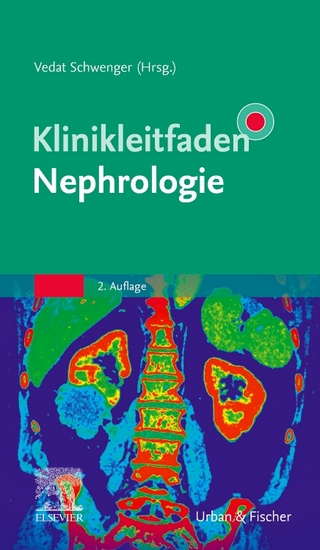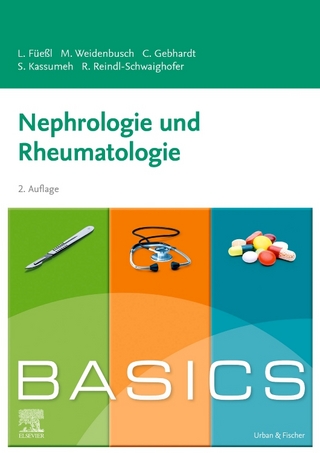
Immune Mechanisms in Renal Disease
Kluwer Academic/Plenum Publishers (Verlag)
978-0-306-40948-6 (ISBN)
- Titel ist leider vergriffen;
keine Neuauflage - Artikel merken
1 Functional Organization of the Glomerulus: Presence of Glycosaminoglycans (Proteoglycans) in the Glomerular Basement Membrane.- 1. Introduction.- 2. Glomerular Capillary Organization Is Highly Specialized.- 3. Epithelial Polyanion Functions to Maintain Normal Foot Processes and Filtration Slits.- 4. Epithelial Slits Effectively Ruled Out as the Main Filtration Barrier.- 5. The GBM Is Both the Size-Selective and the Charge-Selective Barrier in the Glomerulus.- 6. Distinction between Anionic Sites in the GBM and Those on Cell Surfaces.- 7. Anionic Sites Are Lost from the GBM as Well as the Epithelium in Aminonucleoside Nephrosis.- 8. Evidence That the Anionic Sites in the Laminae Rarae of the GBM Consist of Proteoglycans Rich in Heparan Sulfate.- 9. Concluding Comments.- References.- 2 Mechanisms of Glomerular Permselectivity.- 1. Introduction.- 2. The Glomerular Capillary Wall as a Size-Selective Filter.- 3. The Glomerular Capillary Wall as a Charge-Selective Filter.- 4. Effects of Glomerular Injury on the Size-Selective and Charge-Selective Properties of the Glomerular Capillary Wall.- References.- 3 The Molecular Structure of Basement Membranes as It Relates to Function.- 1. Introduction.- 2. Morphologic Considerations.- 3. Physicochemical Properties.- 4. Biosynthesis of Basement Membrane Procollagen.- 5. Immunochemical Properties of Basement Membrane.- 6. Supramolecular Organization.- 7. Molecular Properties of Basement Membranes and Structure-Function Relationships.- 7.1. The Ultrastructural Appearance of Basement Membranes.- 7.2. Permeability Properties of Basement Membranes.- 8. Summary.- References.- 4 Glomerular Basement Membrane Antigens.- 1. Introduction.- 2. Reactivity of Rabbit Anti-GBM with Normal Kidney.- 3. Staining of Kidney with GP Renal Eluates.- 4. Preparations of Isolated GBM.- 5. Measurements of Linear Widths by Immunofluorescent Staining and Phase Microscopy.- 6. Distribution of RAHGBM and GP Antibody Staining in GBM of Diseased Kidneys.- 7. Discussion.- References.- 5 Physiologic Approaches to the Mechanisms of Glomerular Immune Injury.- 1. Introduction.- 2. An Evaluation of Glomerular Capillary Injury by the Use of Micropuncture Techniques.- References.- 6 Physical Interactions between Macromolecules and the Glomerular Filter.- 1. The Nature of the Filter.- 1.1. Physical Chemistry of the Cell Coats and GBM.- 1.2. The Filtration Slit Diaphragms.- 2. Filtration of Macromolecules.- 3. The Physical Basis for Glomerular Restriction.- 3.1. Role Played by the Cell Coats and GBM.- 3.2. Role Played by Slit Diaphragms and Epithelial Pinocytosis.- 4. Summary.- References.- 7 Pathologic and Functional Correlations in the Glomerulopathies.- 1. Introduction.- 2. Methods.- 3. Results.- 3.1. Normal Subjects.- 3.2. Minimal Change Nephrotic Syndrome.- 3.3. Glomerulonephritis.- 3.4. Modification of Permselectivity by Treatment.- 3.5. Prognostic Value of Measurements of Permselectivity.- 4. Discussion.- 5. Summary.- References.- 8 Glomerular Mesangium: Introductory Remarks.- 1. Introduction.- 2. Morphologic and Antigenic Relationships.- 3. Morphologic Tracer Studies.- 4. Kinetic Studies of Mesangial Function.- 5. Modulating Factors Affecting Afferent and Efferent Limb.- 5.1. Afferent Limb.- 5.2. Efferent Limb.- 6. Modulation of Mesangial Afferent and Efferent Limb.- 7. Conclusion.- References.- 9 The Influence of Hemodynamic Factors upon Mesangial Kinetics of Macromolecules.- 1. Introduction.- 2. Methods.- 3. Results.- 3.1. Influence of Reduced Renal Blood Flow and Perfusion Pressure on Mesangial Uptake and Release of Macromolecules.- 3.2. Effects of Ureteral Obstruction upon Mesangial Kinetics of Macromolecules.- 3.3. Mesangial Kinetics of Macromolecules in Mercury Chloride Acute Renal Failure.- 4. Conclusions.- References.- 10 Deposition and Removal of Glomerular Immune Complexes: Relationships to the Mononuclear Phagocyte System.- 1. Introduction.- 2. Removal of Circulating Complexes by the MPS.- 3. Glomerular Deposition of Circulating Immune Complexes.- 4. Removal of Immune Complexes from Glomeruli by Bone Marrow-Derived Macrophages.- 5. Removal of Immune Complexes from Glomeruli by Antigen Excess.- 6. Summary.- References.- 11 LCM Virus Infection and Nephritis.- 1. Description of Chronic LCM Virus Infection in Mice.- 2. Adoptive Immunization of LCM Mice.- 3. Mesangial and Reticuloendothelial Function in LCM Virus Carrier Mice.- References.- 12 Diabetic Nephropathy: Relevance of Animal Models to the Understanding of Pathological Processes in Immune Renal Disease.- 1. The Pathology of Diabetic Nephropathy.- 2. The Glomerular Mesangium in Diabetic Nephropathy.- 3. Reversibility of Mesangial Lesions of Diabetes in Animals.- 4. Glomerular Capillary Permeability and GBM Thickening in Diabetic Rats.- 5. Glomerular Hemodynamics and the Development of Diabetic Nephropathy.- References.- 13 Characterization of Rat Glomerular Cells in Vitro.- 1. Introduction.- 2. Materials and Methods.- 2.1. Culture of Whole Glomeruli and Dissociated Glomerular Cells.- 2.2. Morphologic Studies.- 2.3. Immunological Studies.- 2.4. Phagocytosis in Vitro.- 2.5. Renin Determinations.- 2.6. Studies with Aminonucleoside of Puromycin.- 2.7. Studies with Nephrotoxic Serum.- 3. Results.- 3.1. Isolation of Glomeruli.- 3.2. Culture of Cells from Whole Glomeruli and Dissociated Glomerular Cells.- 3.3. Characteristics of Isolated Cells.- 4. Discussion.- 5. Summary.- References.- 14 Culture of Human Glomerular Cells.- 1. Introduction.- 2. Materials and Methods.- 2.1. Tissue Procurement.- 2.2. Isolation and Culture of Glomeruli.- 2.3. Isolation of Tubular Cells and Fibroblasts.- 2.4. Cytochemical Techniques for Light Microscopy.- 2.5. d-Amino Acid Oxidase Histochemistry.- 2.6. Transmission Electron Microscopy.- 3. Results.- 3.1. Culture of Adult Human Glomeruli.- 3.2. Culture of Infant Human Glomeruli.- 3.3. Ultrastructural Characterization of Cellular Outgrowths.- 3.4. Cytochemical Characterization of Human Glomerular Cells.- 3.5. Biochemical Characterization of Extracellular Matrix Produced by Human Glomerular Cells in Culture.- 4. Discussion.- References.- 15 Immunochemical and Biochemical Studies of Human Glomerular Cells in Culture.- 1. Introduction.- 2. The Immunochemical Approach to Glomerular Cell Specialization: Limitations.- 3. Human Glomerular Cells Types in Vitro.- 4. Early Events in Glomerular Explant Culture.- 5. Glomerular Explant Conditions: Comparative Studies from Bovine Glomeruli.- 6. Summary of Published Reports of Human Glomerular Cells in Vitro.- 7. Specific Markers and the Future of Glomerular Cell Culture.- References.- 16 Results of Immune Complex Detection in Glomerular Diseases.- 1. Introduction.- 2. Detection of IC in Patients with Glomerulonephritis.- 3. Ubiquitous Occurrence of IC in Man.- 4. The Future Use of IC Methods.- References.- 17 Nephritogenic Immune Responses Involving Basement Membrane and Other Antigens in or of the Glomerulus.- 1. Anti-Basement Membrane Antibody Mechanisms.- 2. Anti-Basement Membrane Antibodies and the Diseases They Produce in Man.- 3. Nephritogenic Immune Responses Involving Non-Basement Membrane Antigens in or of the Glomerulus.- 3.1. Non-GBM Glomerular Capillary Wall Antigen in Glomerulonephritis.- 3.2. Foreign Antigens Which Become Trapped or "Planted" within the Glomerulus.- 4. Conclusions.- References.- 18 Autoimmune Disease Induced in Rabbits by Administration of Mercuric Chloride: Evidence Suggesting a Role for Antigens of the Connective Tissue Matrix.- 1. Introduction.- 2. Mercuric Chloride-Induced Autoimmune Disease.- 2.1. Induction and Course of the Disease.- 2.2. Antibodies and Immune Complexes.- 2.3. Search for the Antigen(s) Responsible for the Autoimmune Disease.- 2.4. Systemic Localization of Immune Deposits.- 2.5. Transformation of Anti-GBM Disease into Immune Complex Disease.- 3. Relevance for Human Diseases.- 4. Summary.- References.- 19 Experimental Autoimmune Renal Tubulointerstitial Disease.- 1. Introduction.- 2. Induction of RTD in Guinea Pigs.- 2.1. TBM Antigens.- 2.2. Adjuvants.- 2.3. Strain Differences.- 2.4. Lack of an Effect of Antigen Competition on RTD.- 3. Passive Transfer of RTD.- 3.1. Transfer of RTD with Serum Antibodies.- 3.2. Differences in the Time Course of Passively Induced RTD in Strain 2 and A Strain Guinea Pigs.- 4. Characteristics of Lesions in RTD.- 5. The Role of Complement.- 5.1. Immunofluorescent Observations.- 5.2. Depletion of C with Cobra Venom Factor.- 5.3. RTD in C4-Deficient Guinea Pigs.- 5.4. Differences in Reactivity of in Vivo and in Vitro Bound Anti-TBM Antibodies with Protein A.- 6. The Nature and Origin of the Cellular Infiltrates.- 6.1. Inhibition of Passive Transfer of RTD in Leukocyte-Depleted Recipients.- 6.2. Passive Transfer of Renal Lesions by Anti-TBM Antibody and Nonimmune Bone Marrow Cells to Leukocyte-Depleted Recipients.- 7. Conclusions and Speculation.- References.- 20 Experimental and Human Anti-Tubular Basement Membrane Nephritis.- 1. Introduction.- 2. Experimental Anti-TBM Nephritis.- 2.1. Guinea Pigs.- 2.2. Anti-TBM Nephritis in Rats.- 2.3. Possible Role of Sensitized Cells in Experimental Anti-TBM Nephritis.- 3. Human Anti-TBM Disease.- 4. Summary.- References.- 21 Autoimmunity to Tamm-Horsfall Protein.- 1. Immune Complex-Mediated Tubulointerstitial Nephritis.- 2. TH Protein.- 2.1. Morphologic Localization.- 2.2. TH in Human Disease.- 3. Experimental Anti-TH Antibody-Mediated Tubulointerstitial Nephritis in Rats.- 4. Pathogenesis of in Situ Immune Complex Formation.- References.- 22 Renal Antigens in Experimental Immune Complex Glomerulonephritis.- 1. Introduction.- 2. Materials and Methods.- 2.1. Animals.- 2.2. Induction of Glomerulonephritis.- 2.3. Immunological Procedures.- 3. Results.- 3.1. Immunofluorescence.- 3.2. Immunoelectron Microscopy.- 4. Discussion.- References.- 23 Mechanisms of Proteinuria Induced by Antikidney Antibodies in Noninflammatory Experimental Glomerulonephropathy.- 1. Introduction.- 2. Complement-Independent Nephrotoxic Nephritis in the Guinea Pig.- 3. Experimental Membranous Nephropathy Induced by Antibodies to Renal Tubular Epithelial Cell Antigens.- 3.1. General.- 3.2. Mechanisms of Subepithelial Complex Formation in PHN.- 3.3. Effect of Properties of the Glomerulus on Subepithelial Deposit Formation in AICN and PHN.- 3.4. Kinetics of Glomerular Antibody Binding in Relation to Proteinuria in PHN.- 3.5. Role of Complement in Proteinuria in PHN.- 3.6. Role of Neutrophils (PMNs) in Proteinuria in PHN.- 3.7. Mechanisms of Proteinuria in AICN.- 4. Summary.- 5. Brief Overview-Immunologic Mechanisms of Proteinuria.- References.- 24 The Pathogenesis of Autologous Immune Complex Glomerulonephritis in Rats.- 1. Introduction.- 2. Materials and Methods.- 3. Experimental Groups.- 3.1. Immunizations.- 3.2. Experimental Procedure.- 3.3. Circulating Antibody to RTE.- 3.4. Analysis of CIC.- 3.5. Histology and Immunofluorescence.- 3.6. Size Characteristics of CIC.- 3.7. Detection of RTE Antigens in CIC.- 3.8. Statistical Analysis.- 4. Results.- 4.1. Documentation of Nephritis.- 4.2. Circulating Antibody Studies.- 4.3. CIC.- 4.4. Characteristics of the Clq-Reactive Material.- 4.5. Demonstration of RTE Antigens in CIC.- 5. Discussion.- 6. Summary.- References.- 25 Immunopathogenesis of Murine SLE.- 1. Introduction.- 2. Comparison of SLE in NZB x W, MRL/1, and BXSB Mice.- 2.1. Genetic Background.- 2.2. Immunologic Features of SLE Syndrome in Mice.- 3. Summary.- References.- 26 Studies on Detection of Nephritogenic Immune Complexes.- 1. "Hot" Immunoelectrophoresis.- 2. Dissolving Immune Complexes in Excess of Antigen.- 3. Neutralization and Absorption of Anti-antibody.- References.- 27 The Significance of Cryoimmunoglobulinemia in Immunologically Mediated Kidney Diseases.- 1. Introduction.- 2. Materials and Methods.- 3. Results.- 4. Discussion.- References.- 28 Relationship of Serum Cryoglobulins and Their Composition to Glomerulonephritis in Systemic Lupus Erythematosus.- 1. Introduction.- 2. Evidence Implicating DNA/Anti-DNA Complexes in SLE Glomerulonephritis.- 2.1. Immunofluorescent and Glomerular Elution Studies.- 2.2. Serologic Studies.- 3. Relationship between Cryoglobulinemia and Glomerulonephritis.- 4. Immunochemical Analysis of Cryoprecipitates.- 4.1. Methodology.- 4.2. Anti-immunoglobulins.- 4.3. Antipolynucleotide Antibodies.- 4.4. DNA.- 5. Comment.- References.- 29 Cryoprecipitable Immunoglobulins with Native DNA Reactivity in the Glomerulopathies.- 1. Introduction.- 2. Methods.- 2.1. Patients.- 2.2. Cryoprecipitation of Serum.- 2.3. Antinuclear and Anti-native DNA Assays.- 2.4. Control Studies.- 2.5. Native DNA Content of Cryoprecipitates.- 3. Results.- 3.1. Cryoglobulin Protein Content.- 3.2. Control Studies.- 3.3. Antinuclear and Antikinetoplast (Native DNA) Antibody Content of Cryoglobulins.- 3.4. IgG Anti-native DNA in Cryoglobulins and in Supernatant Serum.- 3.5. Native DNA Content of Cryoglobulins.- 4. Discussion.- 5. Summary.- References.- 30 The Role of Streptococcal and Glomerular Basement Membrane Antigens in Glomerulonephritis.- 1. General Introduction.- 2. A Streptococcal Extracellular Protein Unique to Nephritogenic Strains.- 2.1. Introduction.- 2.2. Methods of Isolation.- 2.3. Polyacrylamide Gel Electrophoresis Pattern.- 2.4. Purification of the Protein.- 2.5. Presence of the Protein in Human Kidney Biopsies.- 2.6. Discussion.- 3. The Role of Altered GBM and Cross-Reactive Streptococcal Antigens in Progressive Glomerulonephritis.- 3.1. Introduction.- 3.2. Background.- 3.3. Methods of Isolation of GBM and Enzymatic Alteration.- 3.4. Cellular Immune Studies in Patients with Progressive Glomerulonephritis.- 3.5. Biochemical Studies of Altered GBM.- 3.6. Discussion.- References.- 31 The Contact (Hageman Factor) System in Inflammation.- 1. Introduction.- 2. Molecules Involved in the Activation of the Contact System in Plasma.- 3. The Association of Activation of Molecules with Limited Proteolytic Cleavage.- 4. A Role of Prekallikrein in the Activation of HF.- 5. A Role of HMW Kininogen in the Activation of HF and Prekallikrein.- 6. Dissemination of Activity into the Fluid Phase.- 7. Cleavage and Activation of HF by Cellular Enzymes.- References.- 32 The Function of the Reticuloendothelial System in Autoimmune Disease.- 1. Introduction.- 2. Hepatic Clearance of Erythrocytes Coated with IgM and Complement via C3b Receptors.- 3. Splenic Clearance of Erythrocytes Coated with IgG via Fc Receptors.- 4. Studies in Human Disease.- References.- 33 A Role of Mononuclear Phagocytes in Immunologically Induced Glomerulonephritis.- 1. Introduction.- 2. An Accelerated Model of NTN with a Mononuclear Cell Component.- 2.1. Experimental Design.- 2.2. Effect of X-Irradiation.- 2.3. Pathogenesis of the Mononuclear Infiltrate.- 3. Conclusions.- References.- 34 Genetic Structure of the HLA Region and Implication for Function.- 1. The Major Histocompatibility Complex.- 1.1. HLA-A,B,C,.- 1.2. Mixed Lymphocyte Response: HLA-D.- 1.3. HLA-DR, The Human "I" Region.- 1.4. CML Typing.- 1.5. Population Studies.- 1.6. Chromosomal Order of Genes (Short Arm of Chromosome 6:6p).- 2. HLA and Disease.- 2.1. Statistical Considerations.- 2.2. Ankylosing Spondylitis.- 2.3. Other Arthritides.- 2.4. The HLA-B8 Group.- 2.5. Multiple Sclerosis.- 2.6. Malignancy.- 2.7. Idiopathic Hemachromatosis.- 2.8. Congenital Adrenal Hyperplasia (21-OH Deficiency).- 2.9. Rheumatic Diseases and C2 Deficiency.- 2.10. Renal Disease.- 2.11. Recombination.- 2.12 Reflections on the Current Disease Association Data.- 3. Mechanisms.- References.- 35 Genetic Defects of the Complement Pathways: Relationship to HLA and Disease.- 1. Introduction.- 2. Association between Complement Deficiences and Disease.- 3. Role of Inherited Complement Deficiencies in Disease.- 4. Summary.- References.- 36 Complement Abnormalities in Allergy and the Nephrotic Syndrome.- 1. Introduction.- 2. Atopy, Complement, and Glomerular Disease.- 3. Conclusion.- References.- 37 Immunogenetic Aspects of Glomerulonephritis.- 1. Development of Immune Complex Glomerulonephritis.- 2. Immune Responsiveness in the Mouse.- 3. Genetics of Nephritis in Experimental Models.- 4. Hypothesis.- 5. Immunogenetic Aspects of Human Nephritis.- 6. Summary.- References.- 38 Autoantibodies in Systemic Lupus Erythematosus.- 1. Introduction.- 2. Autoantibodies to Nucleic Acids.- 3. Antibodies to Histones and DNA-Histone Complexes.- 4. Antibodies to Nonhistone Components.- 5. Discussion.- 6. Summary.- References.- 39 Serological Studies of Antibodies Reactive with RNA and RNA-Protein Antigens.- 1. Introduction.- 2. Antiribosomal Antibodies.- 3. Anti-RNA Antibodies.- 4. Anti-Poly A Antibodies.- 5. Anti-dsRNA Antibodies.- 6. Anti-Nuclear RNP Antibodies.- 7. Anti-La Antibodies.- 8. Antinucleolar Antibodies.- References.- 40 Modulation of Autoimmunity by Sex Hormones.- 1. Sexual Influence in Autoimmune Disease.- 2. Summary.- References.- 41 Thymic and T-Cell Function in Murine and Human Lupus.- 1. Thymic and T-Cell Function in Lupus.- 1.1. NZB and B/W Mice.- 1.2. Human Lupus.- 2. Mechanisms of T-Cell Abnormalities.- 3. Relationships between T-Cell Dysfunction and Pathogenesis of Autoimmunity.- 4. Thymic Substitution or Stimulation in Lupus Syndromes.- References.- 42 Immune Regulatory Abnormalities in Systemic Lupus Erythematosus.- 1. Introduction.- 2. Materials and Methods.- 3. Results.- 3.1. B-Cell Studies.- 3.2. T-Cell Studies.- 4. Discussion.- References.
| Zusatzinfo | biography |
|---|---|
| Sprache | englisch |
| Gewicht | 1200 g |
| Themenwelt | Medizinische Fachgebiete ► Innere Medizin ► Nephrologie |
| ISBN-10 | 0-306-40948-8 / 0306409488 |
| ISBN-13 | 978-0-306-40948-6 / 9780306409486 |
| Zustand | Neuware |
| Haben Sie eine Frage zum Produkt? |
aus dem Bereich


